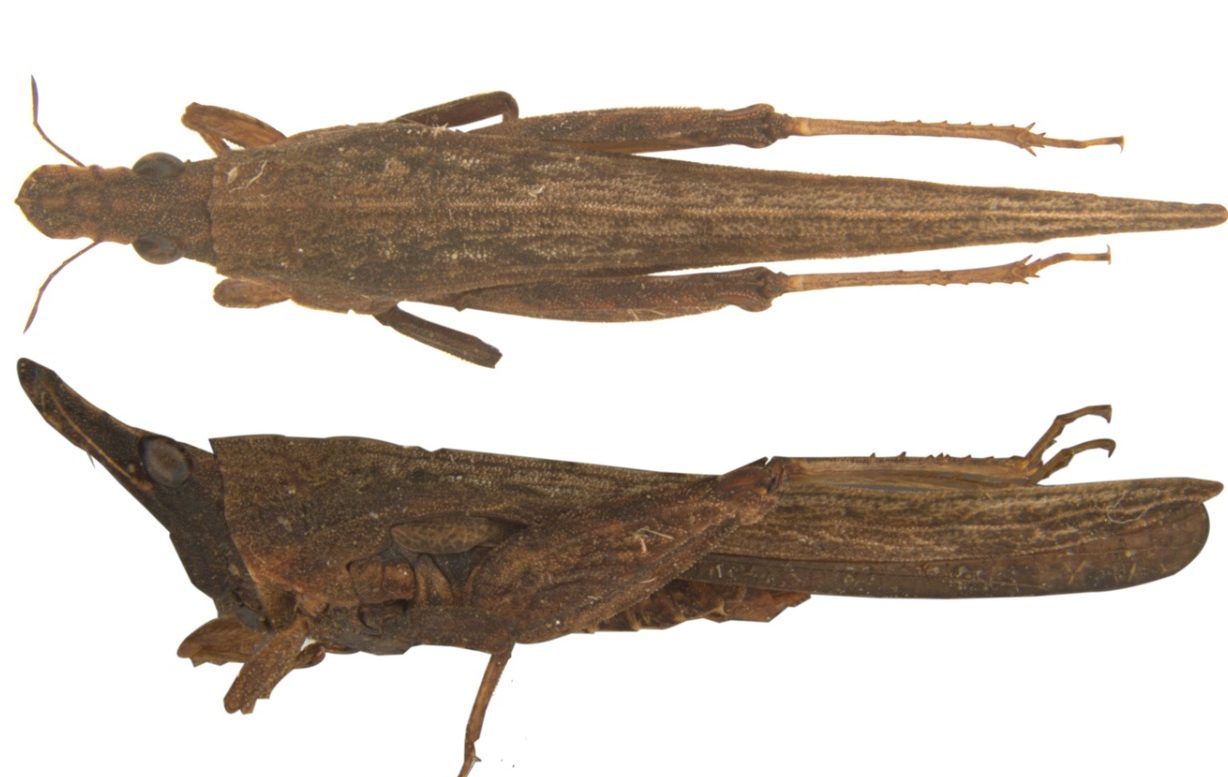It is a new species under a new genus, found with a unique form and structure. But what is even more interesting is the origin of the name!

Picture of newly found grasshopper from Tamil Nadu- Dravidacris Annamalaica. (Credit: Dhaneesh Bhaskar)
A lot of Tamilians believe what they have is a distinct identity. A new grasshopper species, discovered in Chidambaram in Tamil Nadu and amusingly christened “Dravidacris annamalaica“, is also living up to those beliefs.
After all, it is a new species under a new genus, which has been found with a unique morphology, ie, form and structure.
But before getting into more details, here’s a look at why the grasshopper’s name — Dravidacris annamalaica — is as peculiar as its features.
The first part of the name — Dravidacris — was given in honour of the Dravidian landscape and the linguistic group, as the grasshopper was discovered in Tamil Nadu. The word “acris” in Greek refers to grasshopper or locust, and is used in English as both as a prefix or a suffix.
As for the second part, “annamalaica” is an epithet for Annamalai Nagar in Chidambaram, where the specimen was found and collected from. The name “Annamalai” has been Latinised as “annamalaica” to denote the feminine gender of the grasshopper.
The decision to give it a catchy name was a conscious one, said Dr Dhaneesh Bhaskar, a research consultant at the Chennai-based biodiversity research organisation Care Earth Trust, who also headed the team that extensively studied the new grasshopper.
Asked why, Bhaskar explained that it was to get more people interested in grasshoppers and their importance in the food chain and the ecosystem.
For instance, a tree-bark-dwelling grasshopper found at the Eravikulam National Park has been named “Tettilobus trishula”, as it has a protrusion shaped like a trident — or trishul — on its back.
The new grasshopper was first spotted by H Shankararaman, a PhD student in entomology at a university in Chidambaram. He collected the specimen in 2020 out of curiosity and sent it to Bhaskar for further studying. Niko Kasalo, a PhD student from Croatia, assisted in the research work.
Upon receiving the grasshopper specimen, Bhaskar realised that it could be a unique one as he had not seen similar morphology in any other grasshopper species in India. After thorough research, they realised that it was not only a new species, but it was also a new genus. After an extensive review process, the paper was published in the Zootaxa journal on Thursday, 20 October.
Dravidacris annamalaica is now described as a unique pygmy unicorn grasshopper with a long, elevated, and projected vertex. Its sword-like head, the shape of its horn, the way the horn is developed, the expression of the medial and median carinae, and the shape of the anterior margin of the protonum set it apart from other genera of grasshoppers.
According to the researchers, the new grasshopper is restricted to the eastern coast of Tamil Nadu. The specimen was found in a garden-land, semi-urban forest with a sandy surface in Annamalai Nagar.
The habitat was primarily occupied by trees such as monkeypod, coconut, copperpod, and tamarind.
Just like several other grasshopper species, the Dravidacris annamalaica have camouflage properties, Bhaskar pointed out.
Bhaskar’s interest in grasshoppers started when he was pursuing PhD at the Kerala Forest Research Institute. That’s when he started observing invertebrates or the lower fauna more closely.
His interest was piqued when he found that a certain species of grasshopper changed its colour from “normal brown” to “ashy black” because of the practice of burning the grassland for nutrition purposes of the Nilgiri Tahr.
The significance of grasshoppers in the food chain gave the researcher more reasons to extensively study about the insect.
“Grasshoppers are a connecting link between the floral component and the fauna component of the ecosystem. Since it is a rich source of protein, it helps in inducing nutrient cycles. They are also indicators of micro-habitat conditions,” Bhaskar told South First, while explaining why it was important to do more research on grasshoppers.
He added: “For a long time, researchers in India gave grasshoppers a pest status. We want to bring it to the indicator taxa (species that tell us that something has changed or is going to change in the environment) status.”
Bhaskar’s interest took him to several European Natural History museums. In 2020, he became the Regional Vice-Chair for Asia at the International Union for Conservation of Nature, Species Survival Commission, Grasshopper Specialist Group.
He and other researchers are now working towards the “red list” assessment of grasshoppers in India, to document the rare and endangered species.
For Dhaneesh Bhaskar, one of the biggest recognitions of his work was when a group of researchers named a new species of grasshopper after him. The species found in Sri Lanka has been named Cladonotus Bhaskari!

Apr 28, 2024

Apr 27, 2024

Apr 27, 2024

Apr 27, 2024

Apr 27, 2024

Apr 27, 2024